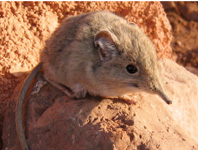Abstract
Based on near-topotypic specimens of Dixonius vietnamensis from Khanh Hoa Province in southern Vietnam genetic analyses showed that the recently described D. taoi is sister to D. vietnamensis and several separate forms exist which previously have been misidentified as D. vietnamensis and D. siamensis. The Dixonius population from Vinh Cuu Nature Reserve, Dong Nai Province, Vietnam, represents an undescribed species. Dixonius minhlei sp. nov. can be distinguished from its congeners based on the following diagnostic characters: small size (up to 47.5 mm SVL); 7–9 supralabials; 14–15 rows of keeled tubercles on dorsum; 20–23 ventral scale rows; 7 or 8 precloacal pores in males; a canthal stripe running from rostrum through the eye and terminating at back of head; lateral second pair of postmentals maximum one quarter the size of first pair; dorsum olive gray with more or less discernible brownish olive blotches. This is the sixth species of Dixonius known to occur in Vietnam.
References
Bauer, M.A., Good, A.D. & Branch, W.R. (1997) The taxonomy of the Southern African leaf-toed geckos (Squamata: Gekkonidae), with a review of Old World „Phyllodactylus“ and the description of five new genera. Proceedings of the California Academy of Sciences, 49, 44–497.
Bauer, M.A., Sumontha, M., Grossmann, W., Pauwels, S.G.O. & Vogel, G. (2004) A New Species of Dixonius (Squamata: Gekkonidae) from Kanchanaburi Province, Western Thailand. Current Herpetology, 23, 17–26.
http://dx.doi.org/10.5358/hsj.23.17Botov, A., Phung, T.M., Nguyen, T.Q., Bauer, A.M., Brennan, I.G. & Ziegler, T. (2015) A new species of Dixonius (Squamata: Gekkonidae) from Phu Quy Island, Vietnam, Zootaxa, 4040 (1), 48–58.
http://doi.org/10.11646/zootaxa.4040.1.4Boulenger, G.A. (1898) Third report on additions to the lizard collection in the Natural History Museum. Proceedings of the Zoological Society London, 1898, 912–923.
Das, I. (2004) A new species of Dixonius (Sauria: Gekkonidae) from southern Vietnam. The Raffles Bulletin of Zoology, 52, 145–150.
Grismer, L.L., Chav, T., Neang, T., Wood, P.L. Jr, Grismer, L.J., Youmans, M.T., Ponce, A., Daltry, C.J. & Kaiser, H. (2007) The herpetofauna of the Phnom Aural Wildlife Sanctuary and checklist of the herpetofauna of the Cardamom Mountains, Cambodia. Hamadryad, 31, 216–241.
Macey, J.R., Ananjeva, N.B., Wang, Y. & Papenfuss, T.J. (2000) Phylogenetic relationships among Asian gekkonid lizards formerly of the genus Cyrtodactylus based on cladistic analyses of allozymic data: monophyly of Cyrtopodion and Mediodactylus. Journal of Herpetology, 34, 258–265.
http://dx.doi.org/10.2307/1565422Macey, J.R., Larson, A., Ananjeva, N.B., Fang, Z. & Papenfuss, T.J. (1997) Two novel gene orders and the role of light-strand replication in rearrangement of the vertebrate mitochondrial genome. Molecular Biology and Evolution, 14, 91–104.
http://dx.doi.org/10.1093/oxfordjournals.molbev.a025706Miller, M.A., Holder, M.T., Vos, R., Liebowitz, T., Chan, L., Hoover, P. & Warnow, T. (2012) The CIPRES Science Gateway V. 3.1. Available from: http://www.phylo.org/sub_sections/portal (Accessed 5 Jul. 2016)
Ngo, V.T. & Ziegler, T. (2009) A new species of Dixonius from Nui Chua National Park, Ninh Thuan Province, southern Vietnam (Squamata, Gekkonidae). Zoosystematics and Evolution, 85 (1), 117–125.
http://dx.doi.org/10.1002/zoos.200800018Smith, M.A. (1935) The Fauna of British India, including Ceylon and Burma. Reptilia and Amphibia. vol. II: Sauria. Taylor and Francis, London, xiv + 440 pp., 2 folding maps, 1 pl.
Stamatakis, A. (2006) RAxML-VI-HPC: Maximum Likelihood-based phylogenetic analyses with thousands of taxa and mixed models. Bioinformatics, 22 (21), 2688–2690.
http://dx.doi.org/10.1093/bioinformatics/btl446Stuart, L.B., Sok, K. & Neang, T. (2006) A collection of amphibians and reptiles from hilly Eastern Cambodia. The Raffles Bulletin of Zoology, 54, 129–155.
Taylor, E.H. (1962) New oriental reptiles. University of Kansas Science Bulletin, 43, 209–263.
http://dx.doi.org/10.5962/bhl.part.13346Taylor, E.H. (1963) The lizards of Thailand. University of Kansas Science Bulletin, 44, 687–1077.
Uetz, P. & Hošek, J. (2016) The Reptile Database. Available from: http://www.reptile-databse.org (accessed 24 Feb. 2016)

